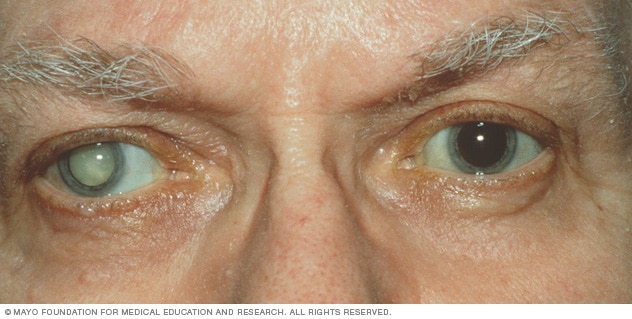10 cataract facts
In this article we will describe 10 cataract facts.

Typical cataract
Key Points
- Definition: A cataract is a opacification (clouding) of the lens in the eye, which can cause vision problems, and eventually blindness.
- Prevalence: Cataracts are a leading cause of reversible blindness worldwide, especially common in older adults. According to the World Health Organisation (WHO), 35% of worldwide blindness is caused by cataracts – a figure that equates to around 20 million people.
- Symptoms: Blurred vision, glare, and difficulty with night vision are classic symptoms.
- Diagnosis: Primarily clinical, supported by slit-lamp examination.
- Treatment: Surgical intervention, usually through phacoemulsification, is the most effective treatment.
1. Definition
- A cataract is an opacity in the crystalline lens of the eye, leading to a decrease in visual acuity.
- The lens, normally transparent, becomes clouded in cataracts, scattering light and reducing the clarity of images formed on the retina.
- Cataracts are often age-related but may also be congenital or associated with other risk factors and conditions.
- Three different types of cataract – nuclear sclerotic, cortical and posterior subcapsular.
2. Epidemiology
- Cataracts are the primary cause of visual impairment in people aged 50 and over, accounting for roughly 35% of cases worldwide.
- In the UK, the condition is prevalent, with an estimated 30% of people over 65 developing significant cataracts.
- Due to an aging population, the incidence is expected to rise, increasing the demand for cataract surgery.
3. Risk Factors
- Age: Cataracts are more common in individuals over 60.
- Family History: Genetic predisposition can increase risk.
- Lifestyle: Smoking, excessive alcohol consumption, and poor nutrition may contribute.
- Environmental Factors: Long-term UV light exposure and occupational hazards like radiation.
- Systemic Conditions: Diabetes, hypertension, and obesity are significant risk factors.
- Medication: Long-term corticosteroid use is associated with increased cataract risk.
4. Causes
- Cataracts occur when proteins in the lens degrade and clump together, creating opaque areas that distort vision.
- This degeneration is often age-related but can also be accelerated by trauma, metabolic changes, or radiation exposure.
- Congenital cataracts, though rare, can result from intrauterine infections, metabolic disorders, or genetic abnormalities.
5. Symptoms
Common symptoms of cataracts include:
- Blurred Vision: Progressive blurring that worsens over time.
- Glare and Halos: Particularly pronounced when looking at bright lights.
- Colour Distortion: Colors may appear faded or yellowed.
- Difficulty with Night Vision: Reduced vision in low-light conditions.
- Double Vision: Often monocular (occurring in one eye only).
6. Diagnosis
Diagnosis of cataracts is based on clinical examination. Key diagnostic steps include:
- Patient History: Assessing for symptoms, risk factors, and impact on daily life.
- Visual Acuity Testing: Reduced visual acuity may suggest cataract progression.
- Slit-Lamp Examination: To directly assess the opacity and any other ocular abnormalities.
- Ophthalmoscopy: Often reveals difficulty in viewing the fundus in advanced cataracts.
Investigation
For most cases, clinical examination suffices. Additional investigations are rarely required but may include:
- Optical Coherence Tomography (OCT): Useful if coexisting retinal pathology is suspected.
- Tonometry: To rule out concurrent glaucoma.
- Ultrasound B-scan: Indicated if a dense cataract obscures fundus details and posterior pathology is suspected.
Differential Diagnosis
The differential diagnosis for cataracts includes:
- Age-related macular degeneration (AMD): Often presents with central vision loss.
- Glaucoma: Chronic open-angle glaucoma may present with gradual vision loss.
- Diabetic Retinopathy: Vision changes due to microvascular changes in diabetes.
- Retinal Detachment: Presents with sudden vision loss and flashes/floaters.
7. Treatment
The mainstay of cataract treatment is surgical removal of the opacified lens, typically replaced by an intraocular lens (IOL) implant. The surgical options include:
- Phacoemulsification: Ultrasonic emulsification of the lens, the most common technique.
- Extracapsular Cataract Extraction (ECCE): A less common approach, generally reserved for very dense cataracts.
Most patients experience significant vision improvement post-surgery. Non-surgical management, such as stronger eyeglasses or magnification, may provide temporary benefit for those with mild cataracts.
8. Complications
While cataract surgery is generally safe, complications may arise, including:
- Posterior Capsule Opacification (PCO): The most common complication, treatable with YAG laser capsulotomy.
- Endophthalmitis: A rare but serious infection post-surgery.
- Retinal Detachment: Slightly increased risk following surgery, especially in myopic patients.
- Cystoid Macular Oedema (CME): Characterized by fluid accumulation in the macula, treated with anti-inflammatory medications.
9. Prognosis
- With modern surgical techniques, the prognosis for patients undergoing cataract surgery is excellent.
- Most regain significant visual acuity, enabling a return to daily activities.
- However, pre-existing ocular or systemic conditions may influence the outcomes.
10. Prevention
Prevention strategies for cataracts include:
- Lifestyle Modifications: Avoid smoking, limit alcohol intake, and ensure a balanced diet rich in antioxidants.
- UV Protection: Wearing UV-blocking sunglasses to reduce cumulative UV exposure.
- Regular Eye Examinations: Early detection of cataracts can allow for timely intervention.
- Glycaemic Control in Diabetic Patients: Proper diabetes management reduces cataract risk.
Summary
We have described 10 cataract facts. We hope you understand them better now.

